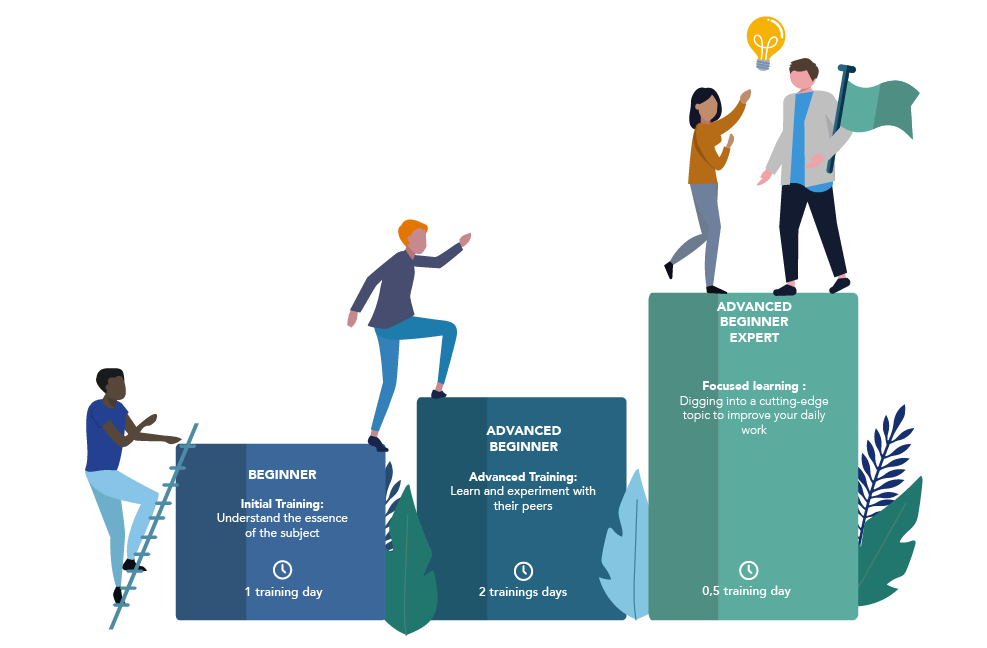Deploying a training program on an entreprise scale is more and more wanted by big organisations. The same training unit is delivered to dozens, even hundreds of collaborators, located in several areas, departments, or countries. It’s a real teaching force being deployed by the entreprise as all participants gain skills and follow the strategic goals set by the entreprise.
However, a difficulty often remains: Disparity among training groups. Those are often randomly created and are too heterogeneous, which brings frustration and switching off. That’s not because of the training’s quality or because of the trainer, but due to the combination of group constitution, expectations, and the level of participants.
Let’s focus on how we can avoid such a situation and create relevant training groups, so that every collaborator can blossom and grow.
1. Understanding the Level of Participants
The first step consists in ranking participants according to their level. Our recommendation is to remain simple and go for three categories: The starter level, the intermediate level, and the advanced level. To define the level of participants, a series of questions should be sent ahead of the training program, including questions regarding:
- Their knowledge:
- How confortable do you feel today about the training’s core subject (from 1 to 10)?
- Have you ever worked in this role/this context (in your current job or in past experiences)?
- Their expectations:
- What do you expect from this training?
- Rank those topics according to your own priorities and interests – the main themes imagined for this training will be listed here
- By the training’s conclusion, I’d like to (tick relevant choices):
- Have a better theoretical knowledge
- Leave with a tool box
- Other: …
- Their context:
- What are the problems you encounter nowadays?
- Which type of projects are you working on?
- Their logistic preferences:
- Would you prefer to take part to the training on site or at distance?
- Knowing that trainings will be on site/at distance, what are your preferred days for this immersive training?
- Do you prefer morning or afternoon?
This simple, quick questionnaire allows to gather key quantitative information to sharpen your group creation.
Another solution to polish the participants’ levels is to exchange with local managers. This solution won’t however fit with every organisation, as it requires availability from the managers.
2. Going for a Pluridisciplinary Audience
For a training on the enterprise’s scale, the ambition of Human Resources and the enterprise overall is to align every collaborator on a same vocabulary and understanding.
To make sure this alignment can be made within the organisation, we recommend to create groups with homogeneous levels, including collaborators with different expertise, from different departments, and so on. This will produce experience sharing from their peers on their day-to-day problems. During the coaching, the trainer must make sure this group of individuals quickly learn to turn into a team. For this, ice-breakers at the start of the session and small group games will be essential for everyone to know each other.
3. Customising the Training Program
Every participant must get a core training program so that they can align themselves to the same reference and take advantage of a customised training. Thanks to dividing into group levels, you’ll be able to make the training program different for every participant, wether they are starters, intermediate, or advanced, so that everyone can learn at their own rhythm.
We recommend a coaching approach in three steps:

4. Getting Participants Involved from the Start
Participants must feel and be involved if they don’t want to have the impression of losing their time. All this starts with communication. The participant must absolutely know why they’re part of this training program, why they’re invited to follow that particular unit, what the level of this training group is, etc. Communicating clearly will allow to better manage expectations and to give information to trigger the participant’s curiosity and get their involvement.
Don’t hesitate to use multiple tools of communication:
- A video or posts on the organisation’s blog/internal social network to showcase the entire training program and its link to the entreprise’s strategic goals
- A conscientious and clear training invite, including the learning goals of the training and its logistics
- A newsletter to bring visibility on the number of participants to the program, collaborator reviews, next steps, etc.
With the help of those advices, you’ll manage to craft more homogeneous level groups, which will – as a consequence – naturally raise the satisfaction level of your collaborators. It’s sometimes difficult to think of pushing back the start of a training program, wether it’s for strategic or logistic reasons, but we’re sure this step is necessary to increase the impact and the collaborators’ satisfaction. It’s even a way to get a more relevant training, adapted to everyone, and therefore with a higher quality.
Wemanity Learning Center is the learning center powered by Wemanity. We apply those advices to the letter and recommend them to our clients. We also learn on a daily basis alongside our clients and lean on experience feedbacks, so we can be sure today that those advices will be precious in your reflexion on bringing your training program to the next level.
In summary:
Wemanity Learning Center recommends the 70 – 20 – 10 method, which means:
70 per cent learning though peer sharing, practice and experience,
20 per cent learning through cases,
and the remaining 10 per cent through theory and ongoing learning.
With this method, you’ll make sure that your public not only becomes more skillful, but also puts those new skills in practice on a day-to-day basis.
Creating groups has many advantages:
– Allow collaborators from different departments and activities to meet, exchange, share, and build together the future of the organisation.
– Harmonising levels to offer a more relevant training, adapted to everyone.
– Having reasonable-sized training groups to make sure there is space for exchange and sharing.
In order to involve your employees throughout the entire training, here are some advices you can follow:
– Having them test a concept before sharing the theory is a technique which works every time. Focusing on practice at the start of the training requires interaction, creativity, and collaboration. This trio allows to keep the public’s interest and to make the understanding of the theory easier.
– Giving breaks to your participants is also a key ingredient to keep them involved.
This will allow them to relax, refresh, but also exchange between them on their learning and their feelings. The trainer will be able to check that the messages they gave are well understood and identify any potential need for clarification.












